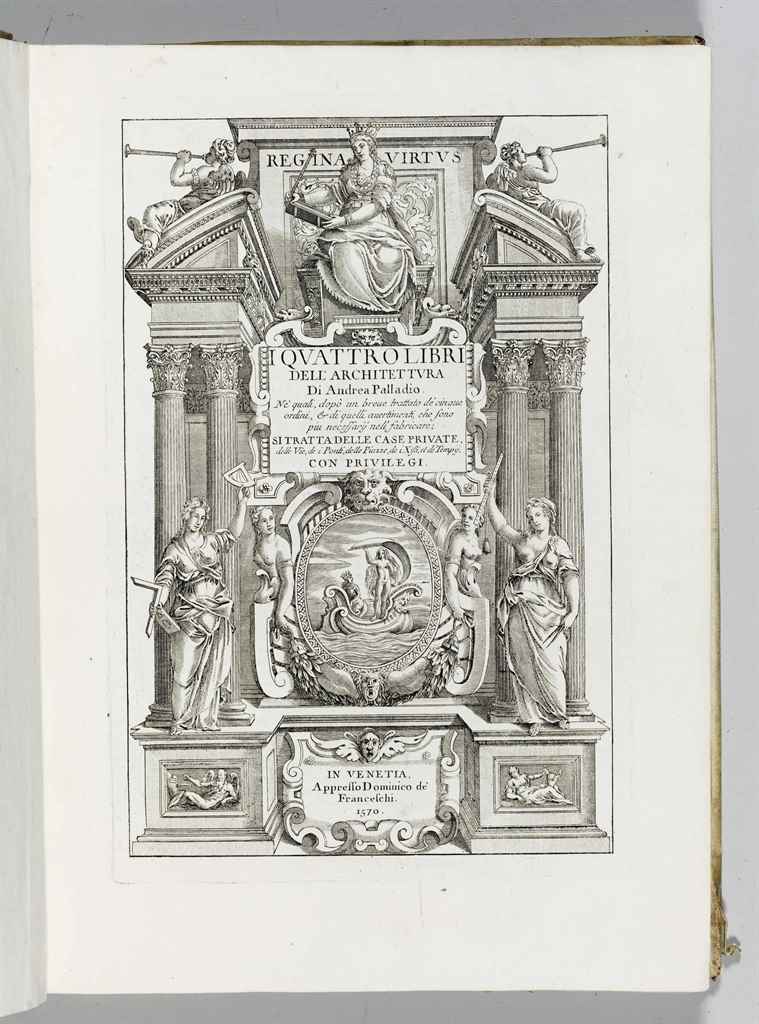Palladio (Andrea) I Quattro Libri dell'Architettura, first edition, 4 parts in 1, collation: A2, B-I4; AA-KK4 (quire HH misbound, in the sequence HH2, HH1, HH4, and HH3); AAA-FFF4; AAAA-RRRR4, complete with blank leaves KK4 and RRRR4, Roman and italic type, each title within architectural woodcut borders with de Franceschi's printer's device included in upper panel, a different printer's device on verso of fol. RRRR3, 221 woodcut illustrations, plans, and sections (156 are full-page blocks, including 84 printed as plates, recto and verso of 42 leaves) executed after Palladio's drawings by Giovanni and Cristoforo Chrieger Cristoforo Coriolano and others, numerous woodcut animated initials, occasional light foxing, lower margin of fol.I2 slightly trimmed, handsome early nineteenth-century green calf, over pasteboards, covers framed by undulating gilt fillet, small floral tools at each corner, spine gilt with gilt-lettered red morocco label, board edges decorated with gilt freeze, green silk bookmark, gilt edges, lower corners slightly bumped, generally a fine copy, folio (290 x 195mm.), Venice, Domenico de' Franceschi, 1570. ⁂ A milestone in the history of architecture: the first edition of the Quattro Libri dell'Architettura by the Paduan theorist and practising architect Andrea di Pietro della Gondola, universally known as Andrea Palladio after the name given to him by his patron and renowned humanist Giangiorgio Trissino. Palladio was primarily active as an architect in Venice, Vicenza, and along the Brenta river, where he built magnificent villas for wealthy members of the Venetian patriciate. This authoritative and influential treatise celebrates the purity and simplicity of classical architecture, drawing its inspiration from Roman sources, especially Vitruvius, and Italian Renaissance architects, above all Leon Battista Alberti The work is divided into four parts or libri, devoted to orders and elementary problems, domestic buildings, public buildings, and town planning and temples. "Palladio followed the rules of classical Roman architecture more closely than any other architect, even sometimes at the cost of practicability and domestic comfort. In spite of the vogue for the baroque and the fact that Palladio left no immediate successors, his book exerted a powerful influence on contemporary architecture and classical ideals until the end of the eighteenth century [...] 'Palladianism' became a party label in the world of connoisseurship and England blossomed with buildings 'in the Palladian style' - two centuries after Palladio had created it. From England the style made its way into Scotland, Ireland and America" (PMM). The treatise was reprinted and translated many times over the following centuries. Within the splendid series of woodcuts which accompany the text, especially noteworthy are those in the second libro depicting plans and elevations of villas, including the famous Villa Maser built for Palladio's patron Daniello Barbaro. Literature: Mortimer Italian, 352; Berlin Katalog 2592; Cicognara 594; Fowler 212; Olschki Choix, 15125; PMM 92.
Palladio (Andrea) I Quattro Libri dell'Architettura, first edition, 4 parts in 1, collation: A2, B-I4; AA-KK4 (quire HH misbound, in the sequence HH2, HH1, HH4, and HH3); AAA-FFF4; AAAA-RRRR4, complete with blank leaves KK4 and RRRR4, Roman and italic type, each title within architectural woodcut borders with de Franceschi's printer's device included in upper panel, a different printer's device on verso of fol. RRRR3, 221 woodcut illustrations, plans, and sections (156 are full-page blocks, including 84 printed as plates, recto and verso of 42 leaves) executed after Palladio's drawings by Giovanni and Cristoforo Chrieger Cristoforo Coriolano and others, numerous woodcut animated initials, occasional light foxing, lower margin of fol.I2 slightly trimmed, handsome early nineteenth-century green calf, over pasteboards, covers framed by undulating gilt fillet, small floral tools at each corner, spine gilt with gilt-lettered red morocco label, board edges decorated with gilt freeze, green silk bookmark, gilt edges, lower corners slightly bumped, generally a fine copy, folio (290 x 195mm.), Venice, Domenico de' Franceschi, 1570. ⁂ A milestone in the history of architecture: the first edition of the Quattro Libri dell'Architettura by the Paduan theorist and practising architect Andrea di Pietro della Gondola, universally known as Andrea Palladio after the name given to him by his patron and renowned humanist Giangiorgio Trissino. Palladio was primarily active as an architect in Venice, Vicenza, and along the Brenta river, where he built magnificent villas for wealthy members of the Venetian patriciate. This authoritative and influential treatise celebrates the purity and simplicity of classical architecture, drawing its inspiration from Roman sources, especially Vitruvius, and Italian Renaissance architects, above all Leon Battista Alberti The work is divided into four parts or libri, devoted to orders and elementary problems, domestic buildings, public buildings, and town planning and temples. "Palladio followed the rules of classical Roman architecture more closely than any other architect, even sometimes at the cost of practicability and domestic comfort. In spite of the vogue for the baroque and the fact that Palladio left no immediate successors, his book exerted a powerful influence on contemporary architecture and classical ideals until the end of the eighteenth century [...] 'Palladianism' became a party label in the world of connoisseurship and England blossomed with buildings 'in the Palladian style' - two centuries after Palladio had created it. From England the style made its way into Scotland, Ireland and America" (PMM). The treatise was reprinted and translated many times over the following centuries. Within the splendid series of woodcuts which accompany the text, especially noteworthy are those in the second libro depicting plans and elevations of villas, including the famous Villa Maser built for Palladio's patron Daniello Barbaro. Literature: Mortimer Italian, 352; Berlin Katalog 2592; Cicognara 594; Fowler 212; Olschki Choix, 15125; PMM 92.















Try LotSearch and its premium features for 7 days - without any costs!
Be notified automatically about new items in upcoming auctions.
Create an alert